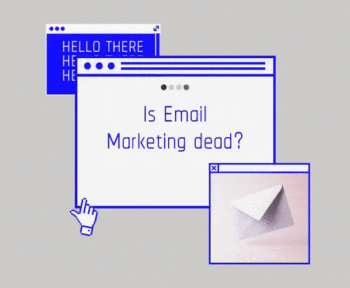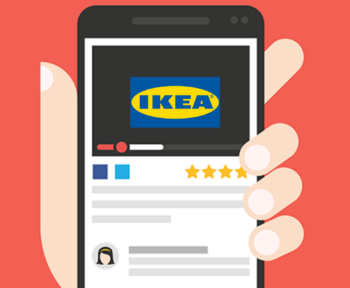
The company leveraged on how air quality impacts health and created a campaign that raised public awareness of localised levels of air pollution.
Can Dynamic Ads be the holy grail of Digital Advertising? Yes, especially if you’re in need of a format full of adaptability, personalisation, and dynamism to effectively reach the right audience.
That’s why they were a clear choice for Philips when the brand was faced with the challenging task of advertising a product in an extremely competitive category.
Join us as we take a look at this success case. One that uses dynamic ads in a fresh way and tackles relevant issues in a time where air pollution, climate change, and global warming are drivers of change.
The Campaign
Philips’s goal was clear: boost sales and increase its market share of the air purifier category within the Czech Republic. Using it’s positioning as one of the world’s leading health technology companies, the brand decided to target the country’s market since the air pollution issue is particularly prevalent in Czech Republic’s large cities with economies reliant on heavy industry.
Instead of choosing a purely commercial approach, Philips created a strategy that resulted in a custom-made campaign that was carried out on two fronts:
- Product marketing messages that aimed to increase market share in an extremely competitive category;
- Awareness messages about air pollution among the Czech population.
According to Google “to address these issues they decided that the campaign would need to create a sense of urgency as well as a reframing of the product as an essential purchase”. Psychology shows we’re more likely to buy a solution when we’re actually feeling the problem. Therefore just like an umbrella when it rains, you’re more likely to buy an air purifier when you know your family health is impacted by poor air quality and heavy pollution.
Philips understood this and made customers able to see the problem in real-time while offering the solution via a dynamic strategy. By using data from pollution measurement stations (thanks to a collaboration with a non-governmental, non-profit organization founded to enforce the right of citizens to breathe clean air), the brand was able to provide accurate readings of air pollution levels in each targeted region.
The levels of air pollution where then segmented into three categories, each with a specific geo-location, message, targeting, and commercial message (product):

Why Dynamic Ads
Since different regions had different pollution levels, dynamic ads were the perfect format for this campaign. This kind of ad makes it able to create campaigns that use geo-location and demographic targeting in order to reach a specific target audience.
Geo-location based dynamic advertising is tailored upon the location of your viewer. This particular method was useful in this context because, in this campaign, targeting and messaging had to be done according to each region’s pollution levels. Various dynamic elements were created — from background color based on category (good, poor, and alarming pollution levels) to location — to allow the relevant banner to be served up to the right targets.

In this strategy, ads adaptation to the viewer was crucial. Hence dynamic ads: an optimal format that can be tailored in real-time to show specific messages and/or ad creative for different consumers. This kind of ad automatically changes in order to adapt content and promotions specifically to each user, ensuring that each user is exposed to the most effective creative for him or her.
Rather than presenting the same static banners across advertising networks, Philips dynamically displayed personalised ads and customised promotions that match user’s unique needs — in this case, the right air purifier according to the pollution level of the area the customer was in.
The Results
Using dynamic banner ads to display localized air pollution levels and A/B testing, the campaign results delivered more than twice the clicks and visits for half the cost:
- 232% increase in ROI
- 42% YoY increase in air purifier sales
- >28% increase in market share
The team ran A/B tests to prove dynamic banners were more effective than static banners. According to Google, the team conducted a controlled A/B testing with static and dynamic banners running in DV360 for a four week period. The results showed that the dynamic banners delivered 22% higher CTR and 16% higher Visit rate in comparison to static banners.
“Between the campaigns Q4 2017 and Q4 2018 the sales increased by 71% and the volume by 94%. Between the campaigns Q1 2018 and Q1 2019 (during the month of January and February), the sales went up by 103% and the volume by 18%. From this point of view, the campaign was very successful,” says Marta Kaczmarczyk, Business Marketing Manager Coffee and AIR, Personal Health Central Europe for Philips Czech Republic.
With this successful campaign, the brand was also able to increase awareness of Philips air purifiers, expand market share, and boost sales and raise understanding of air pollution and its effects.
The campaign was so successful in the Czech Republic that not only was extended but also expanded and rolled out in Slovakia.
Why Should Marketers use Dynamic Ads?
Dynamic ads and campaigns show customers personalised content to increase the relevance of the message. In its core lies adaptability: each ad can be tailored and personalised to match the right audience and the established goals.
This means we’re talking about a format that has great potential when it comes down to the power of personalisation and relevancy. In truth, few forms of digital advertising can match the power of dynamic ads. By now you should be thinking: “well, if they are so effective, sure every marketer is using them, right?”.
Wrong.
According to data from Banner Flow, in 2018, only 17,3% of the served display advertising used dynamic data:
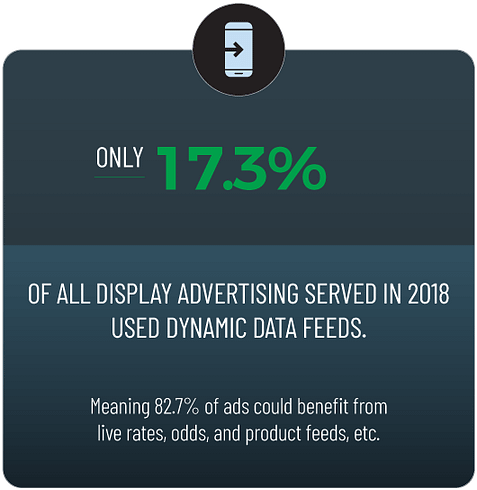
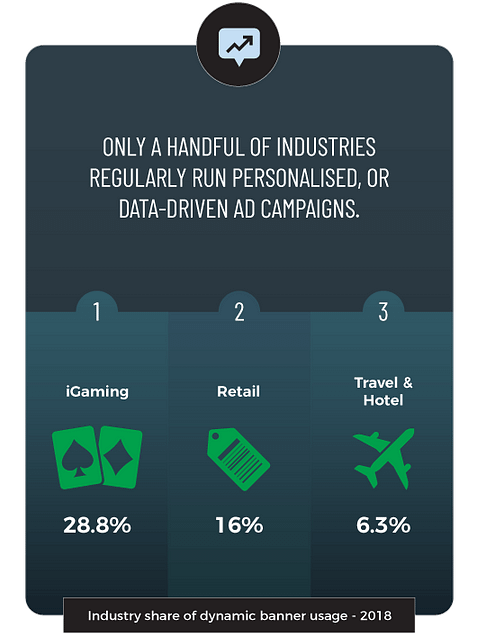
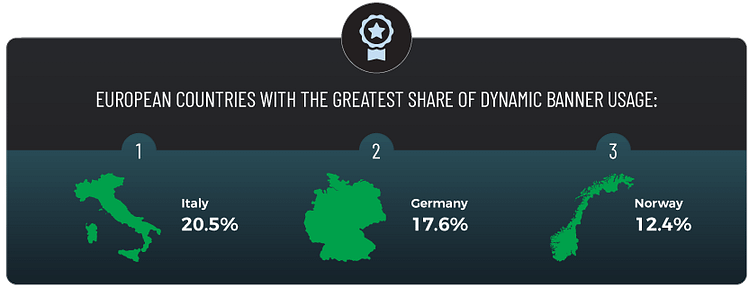
“For today’s marketer, this seems extraordinarily low. Essentially, 82.7% of all display ads could benefit from personalisation and enriched performance through the use of dynamic content. This could either be through the use of live odds, the latest offers, or product feeds, etc”, says the company responsible for the survey.
Dynamics ads also tend to have higher engagement levels, leading to higher marketing ROI alongside with decreased ad spend. Additionally, marketers can expect to improve conversion rates and loyalty with this kind of format, since personal and personalised approaches to customers tend to boost purchase intent and brand sentiment.
Overall, dynamic creatives allow marketers to develop unique ads that are truly relevant to each user.
Pros of Dynamic Ads
- Decreased ad spend and increased campaign ROI;
- Higher conversion rates and customer loyalty;
- Improved search visibility.
Cons of Dynamic Ads
- More expensive;
- More time-consuming;
- Require extensive testing.
Bob Arnold, Data & Measurement, Experience & Design at Google, highlights three principles that guide his team when it comes to dynamic ads:
- Be compelling — attract attention and stand out among competition;
- Be concise — your message needs to be understood quickly because of consumer’s short span of attention;
- Be clear — sometimes, minimalism goes a long way (be sure to also apply this principle on call-to-actions).
“As with any marketing campaign, the success of a banner campaign comes down to creative quality” says Bob Arnold, Data & Measurement, Experience & Design at Google.
Why is Philips Strategy Relevant Nowadays
Air pollution is one of the world’s largest health and environmental problems. According to data, this issue is one of the world’s leading risk factors for death — so much that it contributes to 9% of deaths globally.
Data from a survey conducted by Global Action Plan shows that the majority of adults are, in fact, anxious about air pollution and worried they don’t have enough information about the subject:
- 92% of adults think that reducing air quality should be a priority;
- 83% of adults believe that their health is impacted by outdoor air pollution;
- 65% don’t know who to turn to for information and advice on air pollution.
If you pair this data with the growing relevance of global warming and climate change issues, it’s clear we’re talking about a hot topic that will remain significant and, if nothing changes, more and more urgent from the consumer’s point of view.
Philips strategy leveraged on exactly this: a problem that is real, that has an emotional impact on the customers, and that the brand can help solve. Besides using elements like geo-location, the commercial message was paired with information that was relevant for the user, adding value to the interaction: real-time quality data, health recommendations, pollutant concentration, and information.
The key to success in this context seems to be pairing products with a personalised message that, simultaneously, is also a useful one. As data shows, this problem is real and isn’t going anywhere. So if you’re in the business, maybe it’s time to really consider a strategy like the one Philips used.
See the full Philips Case Study on Think With Google.

